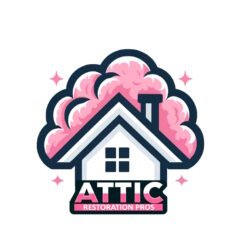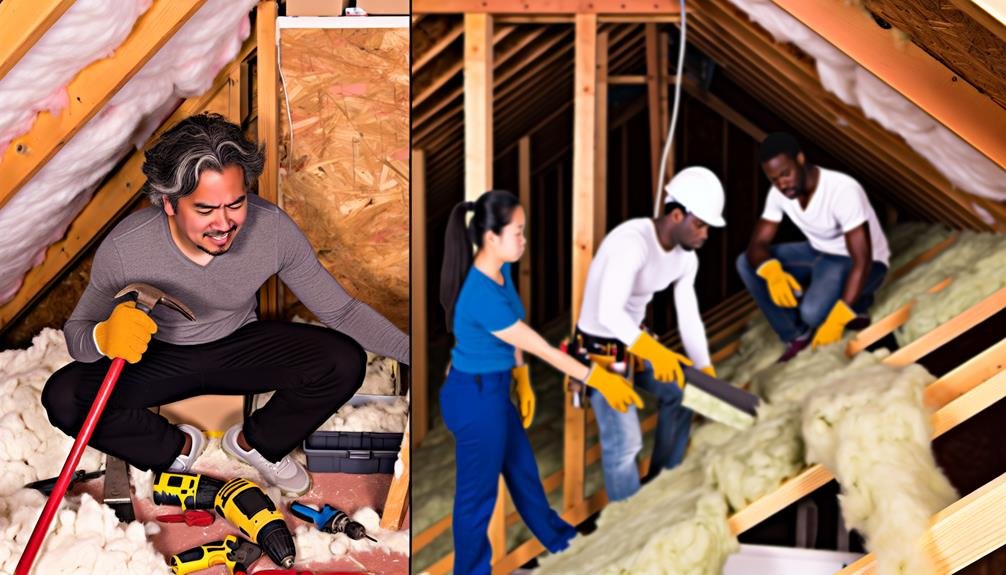When considering attic insulation restoration, the decision to start on a do-it-yourself (DIY) project or hire professionals can be a pivotal one. Factors such as cost, time commitment, safety precautions, required expertise, and the ultimate project outcome all play an important role in determining the best course of action. While some may be inclined to roll up their sleeves and tackle the task independently, others might opt for the expertise and efficiency that professionals bring to the table. The choice between DIY or professional assistance is not merely about the end result but also about the process and potential challenges that may arise along the way.
Key Takeaways
Contents
- Consider cost, time, safety, and expertise before choosing DIY or professional attic insulation restoration.
- Evaluate budget, skills, risks, and desired outcome for cost-effective and efficient decision-making.
- Balance DIY savings, time investment, safety hazards, and project quality for optimal attic insulation results.
- Prioritize project goals, resources, risks, and expertise to achieve successful attic insulation restoration.
Cost Considerations
When evaluating attic insulation restoration options, it is important to carefully consider the associated costs to make informed decisions. One key aspect to consider is whether to tackle the project as a do-it-yourself (DIY) endeavor or to hire professionals for their expertise and quality of work.
Opting for a DIY approach can lead to significant savings in labor costs. By taking on the insulation restoration yourself, you can eliminate the expenses associated with hiring professionals. However, it is essential to assess whether your skills and knowledge are sufficient to make sure the job is done correctly. While DIY savings can be appealing, improper insulation installation can lead to energy inefficiency and potentially higher costs in the long run.
On the other hand, hiring professionals ensures a level of quality that may be challenging to achieve with a DIY project. Professional insulation contractors have the experience, tools, and materials needed to complete the job to a high standard. While this option may come at a higher initial cost compared to a DIY approach, the assurance of professional quality and expertise can provide long-term benefits regarding energy efficiency and cost savings.
Ultimately, when weighing the DIY savings against professional quality, it is essential to take into account your budget, time availability, and confidence in your abilities to determine the most cost-effective and efficient approach for your attic insulation restoration project.
Time Commitment
Considering the time commitment required is essential when evaluating attic insulation restoration options. Whether you choose to tackle the project yourself or hire professionals, understanding the amount of time needed can help you make an informed decision. Here are some key points to contemplate regarding the time aspect of attic insulation restoration:
- DIY Time Commitment: DIY attic insulation restoration can be time-consuming, especially if you have limited experience with this type of project. Plan to dedicate several days to complete the job thoroughly.
- Professional Services: Hiring professionals for attic insulation restoration can save you time and effort. They are equipped with the necessary skills and tools to efficiently complete the project in a shorter timeframe.
- Efficiency Tips: To make the most of your time during the restoration process, organize your tools and materials beforehand. Work systematically and methodically to ensure a smooth workflow.
- DIY Pitfalls: One common pitfall of DIY attic insulation restoration is underestimating the time required. This can lead to rushed work, mistakes, and ultimately, a less effective insulation job. Be realistic about your availability and capabilities before deciding to tackle the project yourself.
Safety Precautions
Implementing proper safety precautions is essential when undertaking attic insulation restoration to safeguard the well-being of individuals involved in the process. Safety gear plays a critical role in ensuring protection against potential hazards during attic insulation restoration. Before starting any work, individuals must equip themselves with the necessary safety gear, including gloves, goggles, respirators, and appropriate clothing to prevent exposure to insulation materials and other harmful substances.
Proper handling of insulation materials is paramount to minimize risks and guarantee a safe working environment. Fiberglass insulation, for example, can cause skin irritation and respiratory issues if not handled correctly. It is important to wear long sleeves, pants, and gloves while working with fiberglass to avoid direct contact with the skin. Additionally, using a respirator can prevent the inhalation of tiny glass fibers present in fiberglass insulation, protecting the respiratory system from potential harm.
When dealing with old or damaged insulation, there is a risk of exposure to harmful substances such as mold, asbestos, or even animal droppings. In such cases, it is crucial to follow proper safety procedures, including wearing appropriate protective gear and ensuring proper ventilation in the attic space. By prioritizing safety precautions and using the right equipment, individuals can effectively mitigate risks and carry out attic insulation restoration tasks in a safe and secure manner.
Expertise Required
Proficiency in insulation restoration techniques is essential for effectively completing attic insulation projects. Without the necessary skills and knowledge, the insulation may not be installed correctly, leading to inefficiencies and potential issues down the line. Here are key points highlighting the skills needed and equipment required for attic insulation restoration:
- Skills Needed:
- Understanding of insulation types: Different insulation materials require specific handling and installation techniques.
- Knowledge of building codes: Compliance with local regulations guarantees the safety and efficiency of the insulation.
- Ability to assess insulation needs: Determining the appropriate R-value and coverage for the attic space is critical for maximum performance.
- Attention to detail: Ensuring a meticulous installation process to prevent gaps or compression in the insulation.
- Equipment Required:
- Insulation materials: Depending on the project, this could include fiberglass batts, cellulose, foam boards, or spray foam insulation.
- Safety gear: Protective equipment such as gloves, goggles, and masks to safeguard against potential hazards.
- Installation tools: Items like utility knives, staplers, insulation supports, and an insulation blower for loose-fill insulation.
- Access equipment: Ladders or scaffolding to safely navigate and work within the attic space.
Having the necessary skills and equipment is essential for a successful attic insulation restoration project. It ensures that the insulation is installed correctly, maximizing energy efficiency and comfort within the home.
Project Outcome
A successful attic insulation restoration project hinges on achieving the desired outcomes for energy efficiency and home comfort. When considering whether to tackle the project as a DIY endeavor or hire professionals, the project outcome plays an important role in decision-making.
Project satisfaction is a key factor in determining the success of attic insulation restoration. DIY projects can provide a sense of accomplishment and potentially save on costs. However, the outcome may vary based on individual skill levels and knowledge of proper insulation techniques. On the other hand, hiring professional insulation experts can guarantee a higher level of project satisfaction as they bring experience, expertise, and access to specialized tools that can result in a more efficient and effective insulation installation.
Insulation effectiveness, both before and after the restoration project, is a critical aspect of the outcome. DIY attempts may not always result in the best insulation coverage, leading to potential energy inefficiencies and decreased home comfort. In contrast, professionals can assess the attic space, determine the best insulation materials and techniques, and guarantee thorough coverage for maximum effectiveness. The difference in insulation effectiveness before and after the project can be significant when comparing a DIY approach to a professional installation, ultimately impacting energy savings and overall comfort levels within the home.

